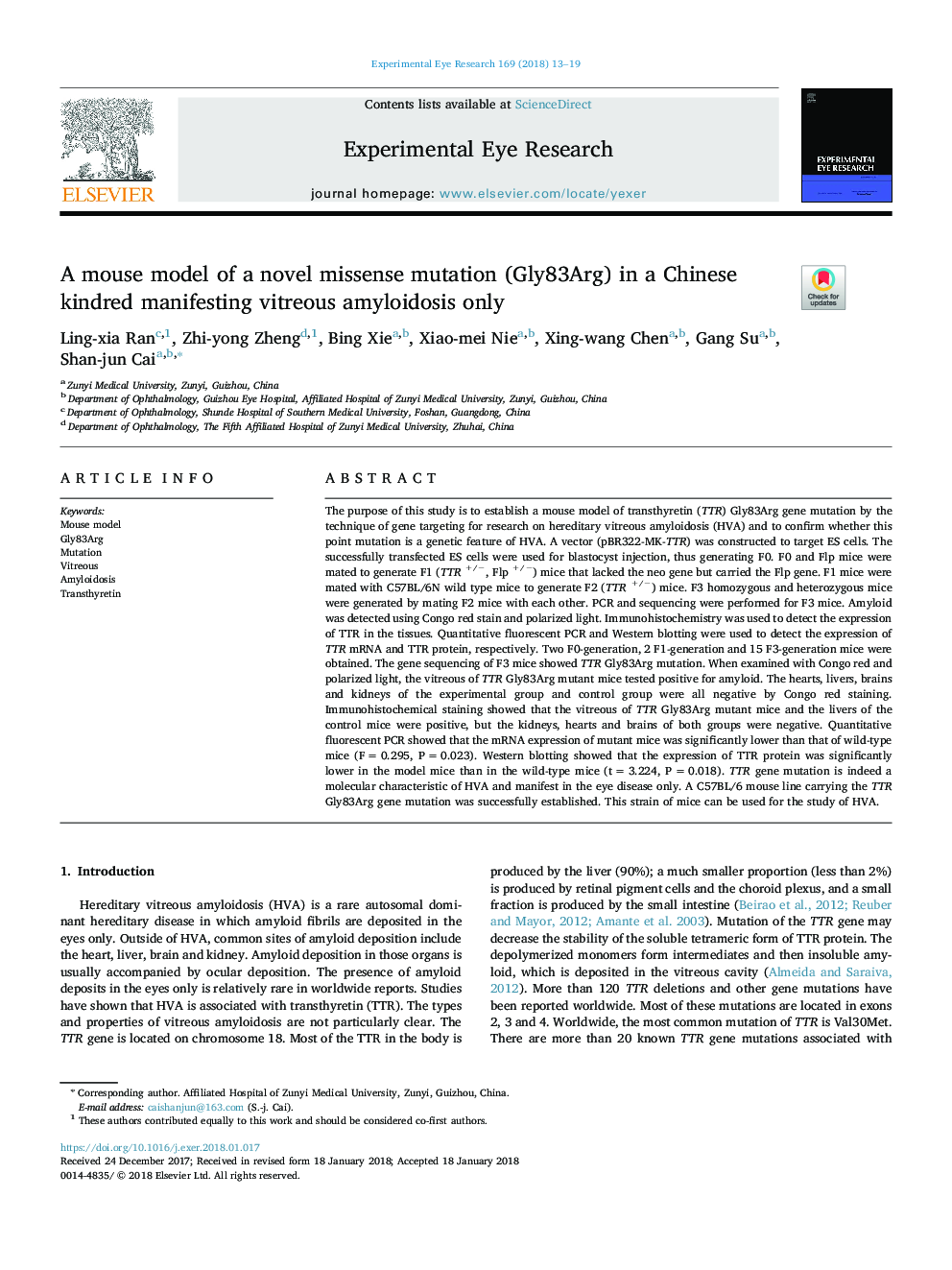| کد مقاله | کد نشریه | سال انتشار | مقاله انگلیسی | نسخه تمام متن |
|---|---|---|---|---|
| 8792019 | 1602553 | 2018 | 7 صفحه PDF | دانلود رایگان |
عنوان انگلیسی مقاله ISI
A mouse model of a novel missense mutation (Gly83Arg) in a Chinese kindred manifesting vitreous amyloidosis only
دانلود مقاله + سفارش ترجمه
دانلود مقاله ISI انگلیسی
رایگان برای ایرانیان
کلمات کلیدی
موضوعات مرتبط
علوم زیستی و بیوفناوری
ایمنی شناسی و میکروب شناسی
ایمونولوژی و میکروب شناسی (عمومی)
پیش نمایش صفحه اول مقاله

چکیده انگلیسی
The purpose of this study is to establish a mouse model of transthyretin (TTR) Gly83Arg gene mutation by the technique of gene targeting for research on hereditary vitreous amyloidosis (HVA) and to confirm whether this point mutation is a genetic feature of HVA. A vector (pBR322-MK-TTR) was constructed to target ES cells. The successfully transfected ES cells were used for blastocyst injection, thus generating F0. F0 and Flp mice were mated to generate F1 (TTR+/â, Flp +/â) mice that lacked the neo gene but carried the Flp gene. F1 mice were mated with C57BL/6N wild type mice to generate F2 (TTR+/â) mice. F3 homozygous and heterozygous mice were generated by mating F2 mice with each other. PCR and sequencing were performed for F3 mice. Amyloid was detected using Congo red stain and polarized light. Immunohistochemistry was used to detect the expression of TTR in the tissues. Quantitative fluorescent PCR and Western blotting were used to detect the expression of TTR mRNA and TTR protein, respectively. Two F0-generation, 2 F1-generation and 15 F3-generation mice were obtained. The gene sequencing of F3 mice showed TTR Gly83Arg mutation. When examined with Congo red and polarized light, the vitreous of TTR Gly83Arg mutant mice tested positive for amyloid. The hearts, livers, brains and kidneys of the experimental group and control group were all negative by Congo red staining. Immunohistochemical staining showed that the vitreous of TTR Gly83Arg mutant mice and the livers of the control mice were positive, but the kidneys, hearts and brains of both groups were negative. Quantitative fluorescent PCR showed that the mRNA expression of mutant mice was significantly lower than that of wild-type mice (Fâ¯=â¯0.295, Pâ¯=â¯0.023). Western blotting showed that the expression of TTR protein was significantly lower in the model mice than in the wild-type mice (tâ¯=â¯3.224, Pâ¯=â¯0.018). TTR gene mutation is indeed a molecular characteristic of HVA and manifest in the eye disease only. A C57BL/6 mouse line carrying the TTR Gly83Arg gene mutation was successfully established. This strain of mice can be used for the study of HVA.
ناشر
Database: Elsevier - ScienceDirect (ساینس دایرکت)
Journal: Experimental Eye Research - Volume 169, April 2018, Pages 13-19
Journal: Experimental Eye Research - Volume 169, April 2018, Pages 13-19
نویسندگان
Ling-xia Ran, Zhi-yong Zheng, Bing Xie, Xiao-mei Nie, Xing-wang Chen, Gang Su, Shan-jun Cai,